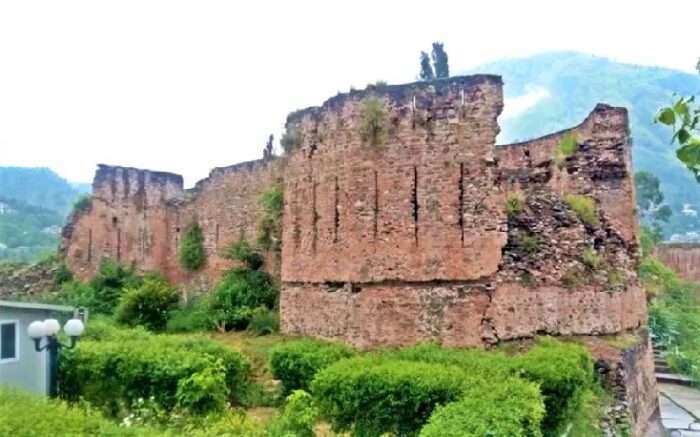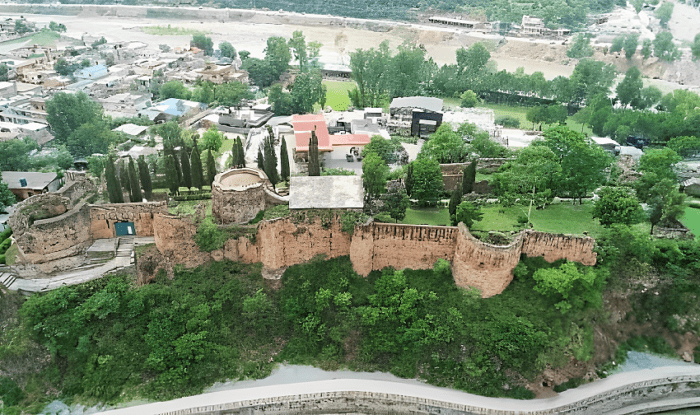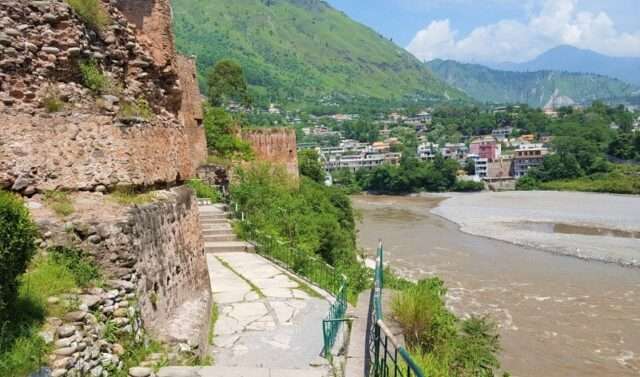Red Fort: a chronicle of Muzaffarabad is one of the historic, scenic and beautiful places in Muzaffarabad city to go and visit.
Kashmir has frequently been referred to as the “Switzerland of the East” and as a paradise on Earth. Kashmir is home to a rich cultural heritage, monuments, and historic wooden and stone buildings.
In Kashmir, several Mughal, Chak, and Sikh dynasties built a large number of historical sites. They provide a good illustration of Kashmir’s history and culture.
A fortification from the 17th century called Red Fort, often referred to as Muzaffarabad Fort, is situated in Muzaffarabad, Azad Jammu and Kashmir, Pakistan. The Kashmiri Chak dynasty constructed it.
Read Also
Locally, the fort is referred to as Rutta Qila or simply qila. Its name is given because of its crimson bricks. Over the years, Red Fort has a significant protective function.
History
The Chuk Rulers began building the fort in 1549, and it was finished in stages by the 20th century. Historians say the fort was built after the Chak rulers of Kashmir realized there was a potential threat to their city from the expansionist Mughals.
The fort was thus built to serve as a raised defensive post that could be a staging ground for counter-offensives.
A substantial rock that is surrounded by a U-shaped curve created by the River Neelum, which flows on its eastern, northern, and western sides, was selected as the site for the fort because of its strategic importance.
The fort was constructed as a second line of defence and shelter for the Fateh Garh Fort at Dub Gali Pass, west of what is now Muzaffarabad, beginning in 1559, under the rule of the Chak Dynasty.

The main gate was located on the eastern side of the upper level of the Red Fort’s three levels. The fort previously had stairs leading from the upper level down to the river, and the two levels were connected by a now-demolished middle level.
However, despite all of the kings’ efforts, the Mughal advance could not be stopped, and Kashmir was eventually captured about 1587. When Emperor Akbar travelled to his recently conquered province, he took this path back to the Mughal capital because it was the simplest.
A royal journey lodge was built for subsequent visits after he spent a week in Chakrs Bahak, which is now Muzaffarabad.
After losing its strategic significance, the fort was abandoned and neglected until Sultan Muzaffar Khan of the Bomba Dynasty, the creator of Muzaffarabad, rebuilt and finished the fort and used it as a military camp in 1646.
Read Also
Olympics 2024 Games will be in Paris
The Dogra Dynasty’s Maharaja Gulab Singh began repairing and expanding the fort once more in 1846, and his successor Maharaja Ranbeer Singh finished the project to restore the fort to its original shape.
After then, the fort was used by the military until 1926, when a new cantonment was constructed, leaving the red fort once more abandoned.
Construction
The Mughals posed a threat to the city, which was foreseen by Kashmir’s Chak rulers.
A key area saw the start of construction in 1559. In 1587, Kashmir was captured by the Mughal Empire, and the fort’s significance diminished.
Sultan Muzaffar Khan of the Bomba Dynasty, who founded Muzaffarabad, oversaw the fort’s final stages of construction in 1646.
Even the materials that went into building and repairing this structure have stories to tell. These elements, which include rounded stones, rubble, red brick masonry, lime, and clay, testify of the evolution of architecture throughout the years.
Despite an earthquake, the fort continues to stand in all its natural majesty, splendour, and history. But the way it is now creates a dark picture of neglect.
Read Also
Noor Mahal: A Majestic Heritage
The entrances and exits of the fort have been severely destroyed, suggesting that it has turned into a shelter for dogs and other animals.
Architecture
The fort’s architecture demonstrates that top architects and engineers were involved in its construction. The Neelum River, originally known as the Kishenganga River, encircles it on three sides.
Terraces and steps going to the river bank were present in the fort’s northern section. However, some areas on the north side have sustained damage.
The eastern side was very well sheltered from the dangers of flood floods. There was an inn near the fort’s entrance, but today only ruins are visible.
It has three levels, with the main gate located on the fort’s southernmost, easternmost level. The lower level is on the northern side; formerly, the stairs down to the river made up the northernmost portion of that side.

A medium level stands between the lower level and the upper, higher level. When Mongols and Mughals were used to invade and rule Pothohar and Hazara in the sixteenth century, the fort was facing west, away from the potential threat.
It was recognized that the Mughals posed a threat and that a fort ought to be erected here.
Abandonment
For use in political and military operations, the fort was extended and rebuilt in 1846 by Maharaja Gulab Singh of the Dogra dynasty. His successor, Maharaja Ranbeer Singh, finished the project.
The red fort was thereafter used by the Dogra military up until 1926, when a new cantonment was constructed and the fort was once again abandoned.
Read Also
Hingol National Park: A Trademark of Balochistan
The fort was abandoned when the Dogra soldiers withdrew in the middle of 1947. Currently, the fort is situated in Muzaffarabad in Kashmir that is governed by Pakistan.
Fort Rehabilitation
The Red Fort is situated along the Neelam River’s bank in a very picturesque area. Even though the fort is largely in ruins, it was encouraging to read from reliable sources that the AJ&K government has started a fort rehabilitation initiative.
A significant amount of the fort’s artifacts were damaged in the 2005 Kashmir earthquake, and the majority was taken.
A company that specialises in repairing historic sites is performing the work.
The little fort nevertheless conveys what a beautiful and imposing structure it would have been in its day, even in its current state where few rooms have roofs that are still in tact and many of the walls are in shambles.
Although it appears that the government has hired people to promote tourism and guard the fort, more work needs to be done to complete its repair.











